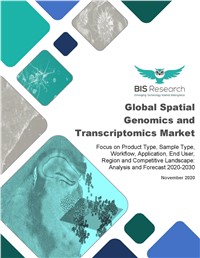Market Report Coverage - Spatial Genomics and Transcriptomics
Market Segmentation
- Product Type – Kits and Assays, Instruments, Software, and Services
- Sample Type – Fresh Frozen Tissues, Fixed Frozen Tissues, Fixed-Formalin Paraffin Embedded Tissues, and Cultured Cells
- Workflow – Spatial Imaging, Spatial Analysis, and Spatial Sequencing
- Application- Diagnostics, Drug Discovery and Development, Translational Research, Single-Cell Analysis, Cell Biology and Others
- End User –Academic and Research Institutions, Biopharmaceutical and Biotechnological Companies, Contract Research Organizations and Other End Users
Regional Segmentation
- North America – U.S., Canada
- Europe – Germany, France, Italy, U.K., Spain, and Rest-of-Europe
- Asia-Pacific – China, Japan, India, Singapore, Australia, and Rest-of-Asia-Pacific (RoAPAC)
- Latin America – Brazil, Mexico, and Rest-of-the-Latin America
- Rest-of-the-World
Growth Drivers
- Increasing Prevalence of Various Types of Genetic Disorders Globally
- Technological Advancements in Sequencing Technologies
- Increasing Research Funding in the Field of Spatial Transcriptomics
Market Challenges
- High Capital Requirement Hampering the Expansion of Global Reach
- Lack of Tools for Computational Analysis
Market Opportunities
- Opportunity (by Product)
- Opportunity (by Technology)
- Expansion into New Research Application such as Spatial Metagenomics
- Expansion into Emerging Markets
Key Companies Profiled
NanoString Technologies, Inc., S2 Genomics, Inc., Flagship Biosciences, Inc., Akoya Biosciences, Inc. RareCyte, Inc., IONpath, Inc., Fluidigm Corporation, 10x Genomics, Inc., Visikol, Inc., Miltenyi Biotec, and BioSpyder Technologies
Key questions answered in this report:
- What are the major market drivers, challenges, and opportunities in the global spatial genomics and transcriptomics market?
- What is the potential impact of biotechnological advancement in the diagnostic industry among the end users, such as researchers, pathologists, and laboratory technicians?
- What is the current market demand along with future expected demand for the global spatial genomics and transcriptomics market?
- How have spatial profiling helped cellular imaging and visualization to become a prominent tool for diagnostics in various clinical applications?
- What are the key development strategies which are implemented by the major players in order to sustain in the competitive market?
- How is each segment of the market expected to grow during the forecast period from 2020 to 2030 based each on segment?
Following are each segment type:
o product type
o sample type
o workflow
o application
o end user
o region, namely, North America, Europe, Asia-Pacific, Rest-of-the-World (ROW)
- Who are the leading players with significant offerings to the global spatial genomics and transcriptomics market? What is the expected market dominance for each of these leading players?
- Which emerging companies are anticipated to be highly disruptive in the future, and what are their key strategies for sustainable growth in the global spatial genomics and transcriptomics market?
Market Overview
BIS Research healthcare experts have found the spatial genomics and transcriptomics market to be one of the most rapidly evolving markets, which is predicted to grow at a CAGR of 23.20% during the forecast period of 2020-2030. The market is driven by certain factors, which include the increasing prevalence of various types of genetic disorders, such as cancer, neurological disorder, and rare diseases, inciting the development of high-resolution multiplex assays and instruments, technological advancements in sequencing technologies, and significant research funding in the field of spatial-based technology for executing R&D exercises.
The market is favored by the development of spatial profiling-based solutions for visualization and analysis of tissue microenvironment, tumor biology, and tissue biomarker. The gradual increase in the prevalence of neurological disorders and rare diseases globally has furthered the spatial genomics and transcriptomics market.
Furthermore, several contract research organizations are focusing on the development of spatial profiling-based services, which enables simultaneous in-situ spatial analysis of multiple biomarkers proteins or more than a hundred mRNAs from single formalin-fixed paraffin-embedded (FFPE) tissue or frozen tissue section.
Within the research report, the market is segmented on the basis of product type, sample type, workflow, application, end users, and region. Each of these segments covers the snapshot of the market over the projected years, the inclination of the market revenue, underlying patterns, and trends by using analytics on the primary and secondary data obtained.
Competitive Landscape
The exponential rise in the application of precision medicine on the global level has created a buzz among companies to invest in the development of high-resolution multiplex diagnostics providing information on cellular interaction and tissue heterogeneity to understand disease biology and pathology. Due to technologically advanced solutions and intense market penetration, BioTechne Corporation has been a pioneer in this field and has been a significant competitor in this market.
Other key players in the market are NanoString Technologies, Inc., S2 Genomics, Inc., Flagship Biosciences, Inc., Akoya Biosciences, Inc. RareCyte, Inc., IONpath, Inc., Fluidigm Corporation, 10x Genomics, Inc., Visikol, Inc., Miltenyi Biotec, and BioSpyder Technologies.
On the basis of region, North America holds the largest share of spatial genomics and transcriptomics market due to improved healthcare infrastructure, rise in per capita income, and availability of state-of-the-art research laboratories and institutions in the region. Apart from this, Europe region is anticipated to grow at the fastest CAGR of 23.54% during the forecast period 2020-2030.
The market utilizes several technologies, such as barcoding, sequencing, mass cytometry, and microscopy, for the development of instruments and assay for spatial profiling of tissue section to gain an understanding of tissue microenvironment. Each solution offered by the leading players is the combination of next-generation omics tools for application in several clinical areas, such oncology, neurology, immunology, and pathology.



